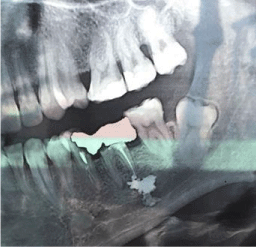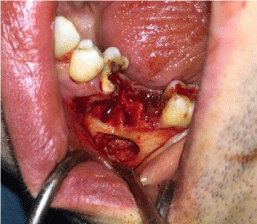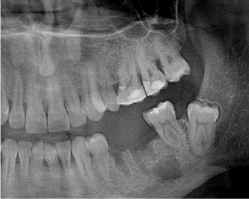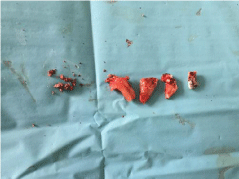Case Report
Surgical Management of Root Canal Overfill without Paresthesia: Case Report
Akçay Ç, Koltuk M and Koseoglu GB*
Department of Oral and Maxillofacial Surgery, Istanbul University, Turkey
*Corresponding author: Koseoglu GB, Department of Oral and Maxillofacial Surgery, Istanbul University, Çapa-İstanbul, Turkey
Published: 31 Mar, 2017
Cite this article as: Akçay Ç, Koltuk M, Koseoglu GB.
Surgical Management of Root Canal
Overfill without Paresthesia: Case
Report. Clin Surg. 2017; 2: 1390.
Abstract
Background: Overfill materials can cause undesirable complications such as neuro-sensorial problems.
Case Description: Report decribes a case of surgical approach to extruded sealant material in a first
left molar which causes neither anesthesia nor pain.
Conclusion: Extruded material extracted immediately in order to prevent any neuro-sensorial
complication
Keywords: Endodontic overfill; Surgery; Endodontic extrusion; Paresthesia
Introduction
The ultimate goal of the endodontic treatment is hermetic obturation. As a complication following the root canal treatment, sealant material can leak from the root canal into bone oral so into the inferior alveolar canal. The present report describes a case of surgical approach to extruded sealant material after endodontic treatment in a first left molar which causes neither anesthesia nor pain.
Case Presentation
A male, 35 year-old patient directed to Department of Oral and Maxillofacial Surgery for
examination and treatment of overfilled root in his first-left molar. Overfill material was noticed in
radiographic examination immediately after the endodontic treatment, only complaint that patient
made is fracture at the treated tooth and related tooth has a huge amalgam filling which has weaken
and caused it to fracture.
According to panoramic radiography (Figure 1), it was thought that the lesion might be related
with alveolar canal. According to CBCT, overfill material seems not to be associated with the canal,
so it was decided to operate patient.
Patient was operated under local anaesthesia. After extraction of first-left molar, mucoperiosteal
flap elevated and a lateral bone window created on the buccal side of the lesion. Overfilled material
was curetted away and the cavity washed with saline solution (Figure 2). The adjacent tooth which was in very poor condition was also removed during surgery. Operation site was closed primarily with 3-0 silk sutures, Non-steroid anti-inflammatory (NSAI) drugs and amoxicillin were prescribed. In control radiography (Figure 3), it was seen that all of the excessive material (Figure 4) was removed
successfully. In tenth day control session, patient shows no signs of
paresthesia, anaesthesia or other complication.
Figure 1
Figure 1
Preoperative panoramic radiography: Sealant material and inferior alveolar canal seem associated.
Figure 2
Figure 3
Figure 4
Discussion
Overfilled canal was described as the one that was well filled in
three dimensions but exhibited surplus filling material past the apex
[1]. Even though spontaneous resorption has been described for
some materials, early surgical removal is suggested. According to
Gonza´lez-Martın et al. [2] use of an electronic apex detector together
with a radiograph taken with the files in position will help to avoid
overextension or perforation.
Poveda et al. [3] and Tilotta et al. [4] presented case reports about mental nerve and inferior alveolar nerve paresthesia associated with endodontic paste. In our case, as it seen in magnetic resonance images, excessive paste material is not related with alveolar canal. As
a result patient feels no discomfort despite extruded material amount
is quite large.
Endodontic treatment complications such as overfill must be
diagnosed well and managed as soon as possible in order to avoid any
sensory disturbances which can be occurred because of mechanical
pressure or chemical toxic reaction of overfilled paste.
Surgical management of the inferior alveolar nerve is effective
in the treatment of nerve injuries caused by endodontic extrusion
of endodontic paste according to Byun et al [5]. In our case patient
feel no paresthesia or anaesthesia, extruded material extracted
immediately in order to prevent any neuro-sensorial complication.
References
- Alan H. Gluskin. Anatomy of an overfill: a reflection. Endodontic Topics. 2009;16:64-81.
- González-Martín M, Torres-Lagares D, Gutiérrez-Pérez JL, Segura-Egea JJ. Inferior alveolar nerve paresthesia after overfilling of endodontic sealer into the mandibular canal. J Endod. 2010;36(8):1419-21.
- Poveda R, Bagán JV, Fernández JM, Sanchis JM. Mental nerve paresthesia associated with endodontic paste within the mandibular canal: report of a case. Oral Surg Oral Med Oral Pathol Oral Radiol Endod. 2006;102(5):e46- 9.
- Tilotta-Yasukawa F, Millot S, El Haddioui A, Bravetti P, Gaudy JF. Labiomandibular paresthesia caused by endodontic treatment: an anatomic and clinical study. Oral Surg Oral Med Oral Pathol Oral Radiol Endod. 2006;102(4):e47-59.
- Byun SH, Kim SS, Chung HJ, Lim HK, Hei WH, Woo JM, et al. Surgical management of damaged inferior alveolar nerve caused by endodontic overfilling of calcium hydroxide paste. Int Endod J. 2016;49(11):1020-9.




